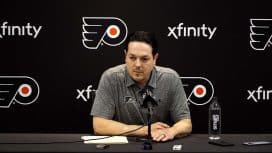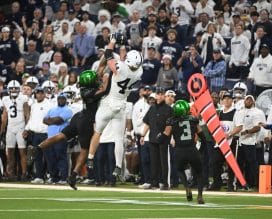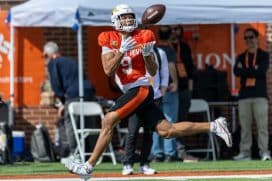Sixers
The Sixers’ Draft-Night Trade Was a Good Start. How Much Flexibility Does the Team Have Heading Into Free Agency?
By Matt Gregan, Sports Talk Philly 76ers Editor
The Philadelphia 76ers were bounced out of the playoffs in the second round in what has become a familiar occurrence in recent team history. Many of the team's weaknesses were exposed, leaving president of basketball operations Daryl Morey with a sizable laundry list of things to improve throughout the roster.
However, the Sixers came into the offseason with their options very limited by the salary cap, effectively leaving Morey not much wiggle room to make any significant moves to the roster.
Despite not having many avenues for improvement this offseason, the team came away from the NBA Draft, the first major event of the offseason, with an acquisition who can help them win now. The team pulled the trigger on a draft-night trade bringing Memphis Grizzlies' reserve guard De'Anthony Melton to Philadelphia.
Melton is a scrappy guard who, while being undersized at 6-foot-2, is capable of defending either guard position while also providing solid 3-point shooting (37.4% on 5.1 attempts per game last season). The 24-year-old is owed $8.25 million for the upcoming season and $8 million for the 2023-24 season. Only $1.5 million of his 2023-24 salary is guaranteed, although there is likely no chance the team will waive him.
Acquiring Melton cost the Sixers veteran wing player Danny Green, whose $10 million salary for next season was non-guaranteed, and the No. 23 overall pick in the NBA Draft (which turned into David Roddy). The move will certainly help improve the Sixers' roster, but it is just a good start and more improvements are still needed, especially at the wing positions.
Before moving forward, now would be a good moment to walk through the Sixers' salary cap situation heading into free agency (all numbers courtesy of spotrac.com). The team is already over the projected $122 million salary cap for the 2022-23 season. Following the Melton trade, they have about $151 million owed to 13 players. This leaves them $4 million below the $155 million apron threshold, which only comes into play if the team chooses to use the full, non-taxpayer mid-level exception (NTMLE), the bi-annual exception (BAE) or acquiring a player through a sign-and-trade deal.
The Sixers already have access to the taxpayer's mid-level exception (MLE) which is valued at $6.392 million. A few potential options for the Sixers at this price range are wings Pat Connaughton (although he has a player option with the Milwaukee Bucks he could potentially pick up) and Danuel House Jr. Using the MLE would not result in a hard cap restriction being placed on them.
However, multiple reports in recent weeks have the Sixers going after free-agent forward P.J. Tucker with a reported three-year, $30 million contract. The only way the Sixers could offer Tucker that contract would be to use the $10.35 million NTMLE. Doing that would require clearing, at the absolute minimum, $7.5 million in order to remain under the apron threshold. This could be done in theory if the team was able to find a team/teams who can absorb Furkan Korkmaz ($5 million) and Matisse Thybulle ($4.379 million). However, in that scenario the Sixers would be nearly right up against the apron threshold (which would act as a hard cap after the usage of the NTMLE) with only 12 players on the roster and no flexibility for any in-season moves.
There are two other potential ways the Sixers can clear the necessary cap space to use the NTMLE. Perhaps the most likely option would be to ship out Tobias Harris. The veteran forward is set to make $37.633 million next season, and there are not many teams capable of taking on his contract (two years, $76.903 million remaining).
If the Charlotte Hornets fail to retain Miles Bridges in free agency, they could potentially be a team the Sixers could ship Harris to. As Bryan Toporek of Forbes Sports dives into, the Sixers could trade Harris to Charlotte for Gordon Hayward ($30.075 million cap hit next season). This would put the Sixers $11.5 million under the apron with 13 players on the roster, freeing up them to use the NTMLE while also having money to fill out the roster with one player on the veteran minimum. One or two small corresponding moves (trading Korkmaz' $5 million cap hit or trading Isaiah Joe's $1.782 million cap hit) can also be made to free up a bit of breathing room under the apron. This move would be a major gamble for the Sixers due primarily to Hayward's durability issues, he played in an average of 48 games over the last three seasons. However, it would be worth the risk due to the combination of his good fit with the team and the opening up of the NTMLE.
Another way for the Sixers to free up space to use the NTMLE is if James Harden takes less money on a contract extension and elects to opt out of his $47.4 million player option for next season. This is not very likely as multiple reports have stated Harden is planning to opt into the player option. However, if he changes his stance and decides to take less money on an extension, the Sixers could very easily free up enough money to use the NTMLE without having to make any other corresponding moves.
The prevailing theory among some coming out of the draft was the Sixers, after trading for Melton, would begin to lean away from attempting to open up enough space for the NTMLE. However, the team is still reported to be the heavy favorites among rival teams to sign Tucker to a three-year, $30 million contract using the NTMLE once free agency begins, according to Marc Stein's latest Substack newsletter.
Whether or not the Sixers are able to clear up enough space to use the NTMLE, Morey will definitely be looking to make the most out of what is, for now, the limited options he has heading into free agency.
"Look, [managing partner Josh Harris and co-managing partner David Blitzer] are going to let us spend whatever we need to spend," Morey said in an interview with reporters after the conclusion of Thursday's NBA Draft. "The CBA constrains us in certain ways; sometimes you don’t get everyone you want because of that. But we think mapping it out the best we can with quite a few options — maybe eight to 12 that we think could contribute and might be in the range of what we’re allowed to do — we feel pretty good that we might get someone that’ll contribute and be in our playoff rotation."





